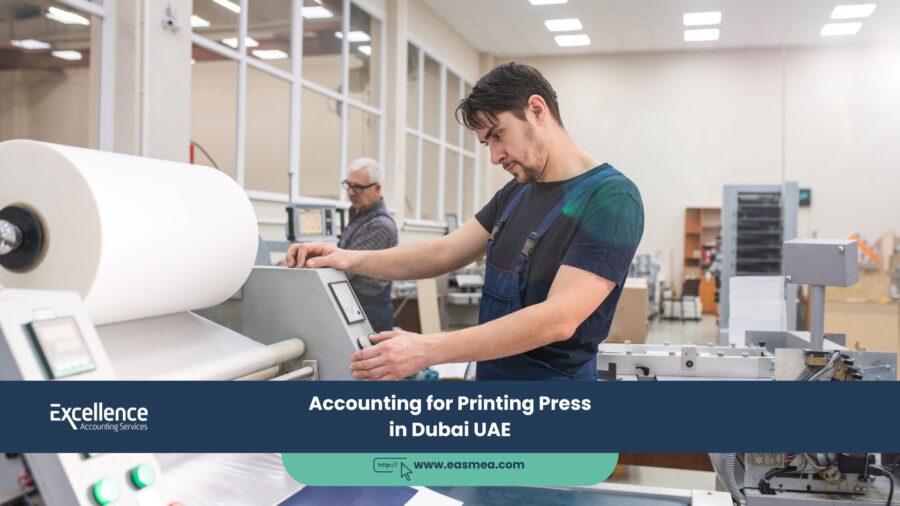Accounting for Printing Press Companies in Dubai, UAE: The 2025 Guide to Manufacturing Profit
In the bustling commercial heart of Dubai, printing presses are the vital engines that give tangible form to communication and marketing. From high-volume commercial printing and luxury packaging to bespoke invitations and large-format graphics, these companies are essential partners to nearly every industry. While the final product is a work of precision and craft, the business of printing is a capital-intensive manufacturing operation where profitability is dictated by efficiency, cost control, and razor-sharp financial management.
Accounting for a printing press in Dubai is a complex task that blends manufacturing costing with service delivery. It involves the meticulous tracking of raw materials like paper and ink, the accurate costing of every print job, the management of expensive machinery, and navigating a competitive market with tight deadlines. Without a robust accounting framework to manage these variables, even a high-volume press can see its profits disappear into unaccounted-for costs and operational inefficiencies.
This definitive guide provides a strategic blueprint for accounting for printing press companies in Dubai, UAE. We will explore the critical financial practices for the industry, from the fundamentals of job order costing and inventory control to the complexities of accounting for capital equipment. We will also provide clarity on the application of VAT and the new UAE Corporate Tax to the printing sector, ensuring your business is fully compliant and financially optimized.
Whether you run a large offset printing facility or a specialized digital print shop, this guide will equip you with the financial knowledge to build a resilient and profitable operation. We will cover industry best practices, essential financial controls, and the reporting that builds confidence with clients, suppliers, and financial institutions, allowing you to print your way to success.
Key Takeaways
- Job Order Costing is Everything: The core of printing press accounting is tracking the exact cost of every single print job, including paper, ink, plates, labor, and machine time, to ensure accurate and profitable pricing.
- Inventory Management is Critical: Effectively managing a diverse inventory of paper stocks, inks, and other consumables is crucial to control costs, reduce waste, and improve cash flow.
- Capital-Intensive Operations: Printing presses are high-value, depreciating assets. Correctly accounting for their acquisition, depreciation, and maintenance is a major financial consideration.
- Calculate Your Machine Hour Rate: To accurately cost jobs, you must calculate an hourly running cost for each major piece of printing equipment, factoring in depreciation, power, maintenance, and labor.
- VAT and Corporate Tax Compliance: Printed goods and services are subject to 5% VAT. Understanding this, along with the impact of the 9% Corporate Tax on your manufacturing profits, is essential for compliance.
The Financial Anatomy of a Printing Press
A printing press is fundamentally a manufacturing business. You take raw materials—paper, ink, plates—and use labor and machinery to convert them into a finished product based on a customer’s specific order. The financial model is built on managing the “cost of goods sold” with extreme precision and maximizing the throughput and efficiency of your expensive capital equipment. Success depends on winning jobs at a profitable price and producing them with minimal waste and maximum efficiency.
Operating in Dubai’s dynamic market means adhering to environmental and safety regulations, often guided by bodies like the Dubai Municipality, particularly concerning waste disposal and the handling of chemicals. These compliance costs must be factored into your overall business operating model.
The Core Principle: Job Order Costing
Because every print job is unique, the most critical accounting process for a printing press is the job order costing system. You cannot use an average cost; you must know the precise cost of producing each specific job to ensure it was profitable. A job cost sheet (or its digital equivalent) must be created for every single order that comes through your press. This sheet accumulates all the direct costs associated with that job.
The essential costs to track for each job are:
- Direct Materials: The exact cost of the paper, ink, printing plates, and any other specific materials used.
- Direct Labor: The wages of the press operators, prepress technicians, and finishing staff for the time they spent working on that specific job.
- Factory Overhead: A portion of the factory’s indirect costs, allocated to the job. This is typically applied based on the number of machine hours the job used.
In printing, the job cost sheet is the blueprint of profitability. It tells the financial story of a job from raw paper to finished product.
By totaling these costs and comparing them to the price you charged the client, you get the gross profit for that job. This data is the most powerful tool you have. It tells you which types of jobs are most profitable, which clients are most valuable, and whether your estimating and quoting process is accurate. A professional bookkeeping service can be instrumental in implementing a robust job costing system.
Inventory Control: Paper, Inks, and Consumables
Your raw materials inventory is a significant asset that needs to be tightly controlled. Paper is often the largest component, and you may stock a wide variety of types, weights, and finishes. Inks, plates, solvents, and finishing materials also represent a substantial investment. An effective inventory management system, integrated with your accounting software, is crucial for several reasons.
First, it ensures that when materials are used for a job, their cost is accurately transferred from the “Inventory” asset account to the “Work in Progress” account for that specific job. This is essential for accurate job costing. Second, it helps prevent waste, spoilage, and theft. Third, by tracking usage rates, the system can help you optimize your purchasing, ensuring you have enough stock of popular items without tying up excessive cash in slow-moving inventory. This improves your cash flow and reduces storage costs.
Managing Your Most Expensive Assets: The Machinery
A printing press is a capital-intensive business. The printing presses themselves, along with cutting, binding, and finishing equipment, represent a multi-million-dirham investment. The way you account for these assets and their running costs has a huge impact on your financial statements and your ability to price jobs profitably.
Depreciation and Maintenance Costs
When you purchase a new printing press, its cost is recorded as a fixed asset on your balance sheet. This cost is then systematically expensed over the machine’s estimated useful life through depreciation. This non-cash expense reflects the wear and tear on the machine as it’s used to generate revenue. This depreciation cost must be factored into your overall business costs.
Maintenance is another major expense. Routine maintenance costs are typically expensed as they are incurred. However, the cost of a major overhaul that significantly extends the life or improves the capability of a machine may be capitalized and depreciated over the remaining life of the asset. A clear policy for distinguishing between routine repairs and major overhauls is an important accounting decision.
Calculating Machine Hour Rates for Accurate Costing
To accurately allocate your factory overhead costs to individual jobs, you need to calculate a “machine hour rate” for each of your key pieces of equipment. This is a calculated hourly cost of running the machine. It is a crucial component of your job costing system. The rate is calculated by taking all the annual costs associated with running that machine and dividing them by the number of hours you expect to run it in a year.
| Cost Component for Machine Hour Rate | Examples |
|---|---|
| Machine Depreciation | The annual depreciation expense for that specific press. |
| Indirect Labor | Salaries of factory supervisors and maintenance staff. |
| Power & Utilities | The electricity cost to run the press. |
| Rent & Space | A share of the factory rent based on the floor space the machine occupies. |
| Maintenance & Spares | The estimated annual cost of routine maintenance and spare parts. |
Once you have this hourly rate (e.g., AED 500 per hour), you can accurately apply overhead to a job. If a print job takes 3 hours to run on that press, you would allocate AED 1,500 (3 hours * AED 500/hour) of factory overhead to that job’s cost sheet. This is a far more accurate method than simply applying a blanket percentage.
Navigating Tax and Compliance in Dubai
A professional printing press in Dubai must be fully compliant with the UAE’s tax regulations, primarily VAT and the new Corporate Tax. A clear understanding of these laws is essential for correct invoicing, cost management, and avoiding penalties from the Federal Tax Authority (FTA). For the most reliable information, business owners should always refer to the official FTA website.
VAT on Printing and Related Services
The supply of printed goods (like brochures, books, and packaging) and related services (like graphic design) in the UAE is subject to the standard 5% rate of VAT. You must be registered for VAT if your annual turnover exceeds the mandatory threshold, and you must issue tax-compliant invoices that clearly show the 5% VAT charge. You are responsible for collecting this tax from your clients and remitting it to the FTA.
Crucially, you can reclaim the input VAT you pay on your business expenses. This includes the VAT on your purchases of paper, ink, new machinery, maintenance services, and factory rent. An organized accounting system is vital for meticulously tracking all your input VAT to ensure you reclaim every eligible dirham, which directly improves your company’s cash flow. Our specialized VAT services can help ensure your compliance.
Corporate Tax for Printing Presses
Your printing press will be subject to the 9% UAE Corporate Tax on its annual taxable profits exceeding AED 375,000. Your taxable profit is based on your IFRS-compliant financial statements. This makes your accounting policies for inventory valuation, depreciation, and cost allocation critically important, as they directly impact your tax liability. All legitimate business expenses, including the cost of goods sold, salaries, and overheads, are deductible. Maintaining complete and accurate records for every transaction is mandatory to support your tax return. Professional corporate tax services are essential for navigating these requirements.
What Excellence Accounting Services Can Offer
At Excellence Accounting Services (EAS), we have deep expertise in the manufacturing and production sectors. We understand the unique financial challenges of the printing industry, from the complexities of job costing to the management of capital-intensive assets. We offer specialized accounting services to provide the financial control and insight you need to run a profitable press in Dubai.
Our specialized offerings for printing companies include:
- Job Order Costing System Implementation: We help you design and implement a robust system to track the exact cost and profitability of every single print job.
- Inventory Accounting and Control: We can help you set up systems to manage your inventory of paper, ink, and other materials, ensuring accurate costing and minimizing waste.
- Fixed Asset Management: We manage the accounting for your machinery, including calculating depreciation and advising on the capitalization of major overhauls.
- VAT and Corporate Tax Compliance: Our tax experts will handle all your FTA filings, ensuring you are fully compliant and your tax position is optimized.
- Budgeting and Financial Analysis: We provide detailed financial reporting, including budget vs. actual analysis, to help you control costs and improve profitability.
By partnering with EAS, you gain a financial team that understands the mechanics of your industry. We handle the numbers so you can focus on producing high-quality print work for your clients.
Frequently Asked Questions (FAQs)
Paper wastage (spoilage) is an expected part of the printing process. The cost of “normal” spoilage should be treated as a factory overhead cost and included in the calculation of your machine hour rate. This way, the cost of normal waste is spread across all jobs. However, if a specific job results in “abnormal” spoilage (e.g., due to a major machine malfunction or operator error), the cost of that wasted material should be charged directly to the Cost of Goods Sold for that period and should not be included in the cost of the job itself. This prevents one bad job from distorting your profitability data.
Since you did not purchase the paper, it is not part of your inventory and you do not have a material cost for it on the job cost sheet. This is known as “customer-supplied material.” However, you are still providing the service of printing on that paper. Your job cost sheet will still include your direct labor costs and the factory overhead allocated based on the machine time used. Your quote to the client should reflect that you are only charging for the printing service, not the materials.
This is a major capital budgeting decision. It’s not just about whether the old machine is still working. You need to do a financial analysis comparing the costs and benefits of keeping the old machine versus buying a new one. This involves looking at the higher maintenance costs and potential downtime of the old machine versus the purchase price and depreciation of the new one. You should also consider the benefits of a new machine, such as higher speed (more throughput), better quality, and lower energy consumption. A financial statement analysis and cash flow projection can help you make an informed decision.
Yes. If you provide graphic design as part of a print job, it is considered part of the overall supply of printed goods and services. The entire value of the invoice, including any separate line item for design fees, is subject to the standard 5% VAT rate. You cannot treat the design portion as a separate, non-taxable supply.
This is a complex part of inventory management. The ink used for a specific job is a direct material cost. The ink left over is technically still part of your inventory. In practice, for standard inks like CMYK, presses often have dedicated ink reservoirs, and the cost is managed as a general consumable. For special Pantone or custom-mixed inks purchased for a specific job, any significant amount left over should ideally be returned to your inventory. However, small, unusable amounts are often treated as part of the material cost of the job or as normal factory overhead.
This highlights the importance of having strong terms and conditions. Your contract with the client should include a cancellation clause that specifies they are liable for any costs incurred up to the point of cancellation. You should invoice the client for the cost of the special paper you purchased on their behalf. From an accounting perspective, if the paper is unique and you cannot use it for any other job, its value as an inventory item is zero. You would need to “write down” the inventory, recording its cost as an expense.
This depends on your workload. A fixed salary provides stability for your employees but is a fixed cost for you, regardless of how busy the press is. An hourly wage makes your labor cost more variable, which can be beneficial if your workload fluctuates significantly. Many presses use a hybrid model: a core team of senior operators on a fixed salary to ensure stability and quality, supplemented by more junior or temporary staff on hourly wages who can be scheduled flexibly based on demand.
Yes. The import of goods into the UAE is subject to 5% VAT, which you would typically pay at the time of customs clearance. As a VAT-registered business, this VAT you pay on the import of the machine is considered “input VAT.” You are entitled to fully reclaim this amount on your next VAT return, offsetting it against the output VAT you have collected from your customers. This is a critical cash flow point, and ensuring your import documentation is correct is essential for a smooth reclaim process.
The most common reason is inaccurate quoting due to a poor understanding of true costs. Many presses lose money because their quoting process is based on guesswork or historical prices without a link to the actual, current costs of labor, materials, and machine time. Without a robust job costing system, they don’t realize that certain types of jobs or clients are consistently unprofitable. They might be very busy, but their profit margins are being eroded by unaccounted-for costs, leading to a situation of “profitless prosperity.”
Your accounting data, particularly from your job costing system, is a powerful tool for improving efficiency. By analyzing the actual time and materials used on jobs versus your initial estimates, you can identify areas of waste or inefficiency. For example, if jobs on a particular machine consistently take longer than estimated, it might signal a need for maintenance or better operator training. If paper wastage is high, it might point to a need for better setup procedures. Data allows you to pinpoint problems and make targeted improvements to your production process.
Conclusion: The Blueprint for a Profitable Press
In the competitive printing industry of Dubai, the quality of your output is paramount, but the health of your business is written in your financial statements. A successful printing press operates on a foundation of financial precision, where every sheet of paper, every drop of ink, and every minute of machine time is accounted for. This disciplined approach to accounting is what separates the most profitable presses from the rest.
By embracing a robust job order costing system, maintaining tight control over your inventory and capital equipment, and navigating the UAE’s tax landscape with expertise, you can build a business that is as strong and resilient as it is creative. This financial clarity gives you the power to price with confidence, manage costs effectively, and invest in the technology and people that will drive your future growth. In the world of print, sound accounting is the blueprint that ensures a flawless and profitable final impression.
From Prepress to Profit.
Let Excellence Accounting Services provide the specialized financial management your printing press needs to succeed in Dubai's competitive market.




